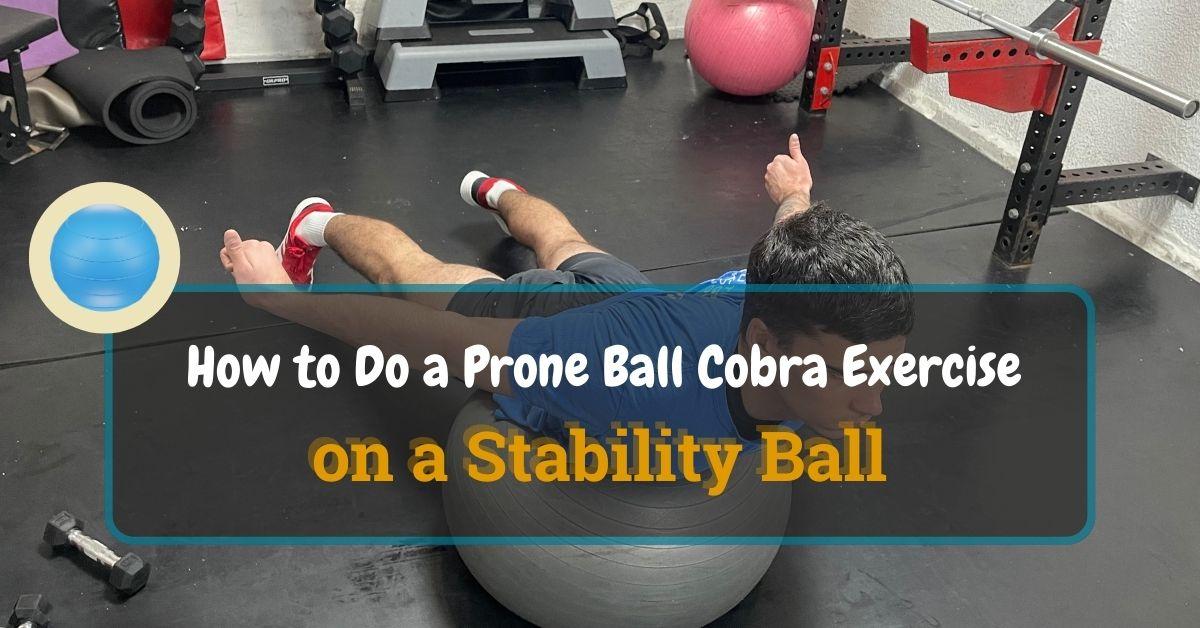The prone ball cobra exercise is a pivotal movement for enhancing back strength and stability using a stability ball. This exercise not only targets your lower back muscles but also engages your glutes and shoulder stabilizers, making it an essential addition to any fitness or rehabilitation routine.
Table of Contents
ToggleUnderstanding how to perform this exercise correctly can lead to significant improvements in posture and functional strength.
In this article, you will learn:
- The correct steps to perform the prone ball cobra exercise on a stability ball.
- The key benefits and muscles worked by the prone ball cobra exercise.
- Practical tips and variations to maximize the effectiveness of the exercise.
Let’s dive into the detailed steps to ensure you’re getting the most out of your prone ball cobra exercise.
Start Building Your Dream Body Today
Ready to elevate your fitness game without falling into the trap of dull, repetitive routines that just don’t deliver? Imagine sculpting your ideal physique and boosting your health, all while still enjoying life’s pleasures, like those irresistible weekend getaways and your aunt’s legendary cheesecake. With our online fitness and nutrition coaching service, you don’t have to compromise. Dive into a personalized fitness journey that blends perfectly with your lifestyle, not against it. Book your completely free discovery consultation today, and take the first step towards a transformation that doesn’t require giving up the joys of life.

“I was skeptical about online fitness coaching, but Functional Body Savage completely changed my perspective. Vanja and Radomir’s personalized approach and attention to detail have helped me achieve goals I never thought possible. I’m stronger, more confident, and grateful for their guidance.”
Emily Thompson, San Francisco, CA
Learn More About Our Online Coaching ServiceHow to Do a Prone Ball Cobra Exercise on a Stability Ball
Here is how to do a prone ball cobra exercise on a stability ball.
Step One — Assume the Starting Position
Ensure you have a stability ball that suits your height. When seated, your knees should be at a 90-degree angle. Lie face down on the stability ball, with your torso and hips on the ball and feet firmly planted on the ground for stability.
Your legs should be straight, and your toes should be touching the floor. Extend your arms in front of you, palms facing each other. This starting position primes your body for the exercise, engaging the necessary muscles for an effective workout.
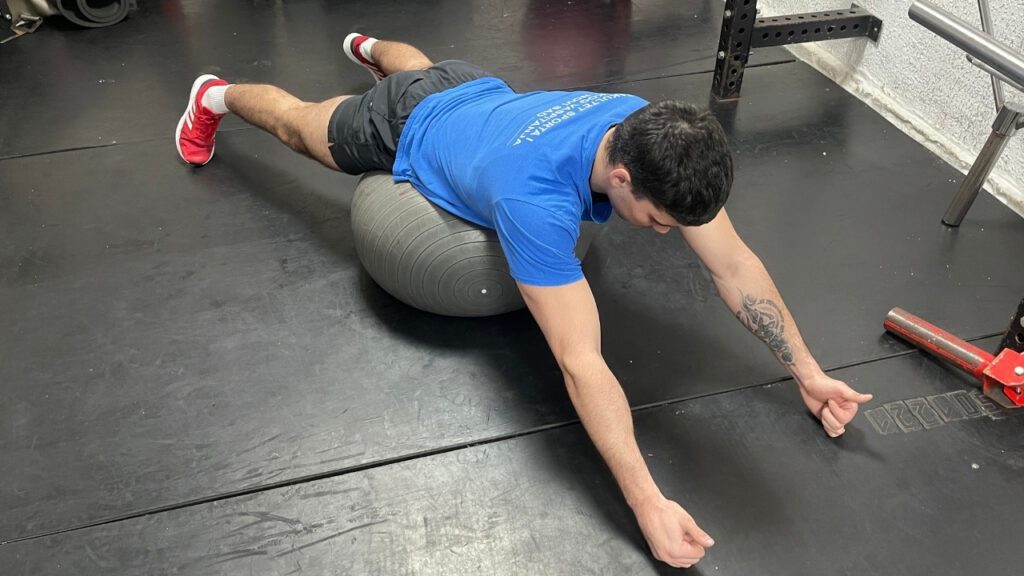
Pro Tip: Adjust the stability ball’s position under your abdomen to either increase or decrease the difficulty level of the exercise, making it adaptable to your fitness level.
Step Two –- Enter the Cobra Position
Before moving, tighten your abdominal muscles to stabilize your spine. Gently lift your chest off the ball, pulling your shoulder blades down and back. As you lift, extend your arms out to the sides and rotate them so your thumbs point upwards.
This movement mimics the shape of a cobra’s head and neck, hence the name. At the top of the movement, squeeze your shoulder blades together for a moment to maximize muscle engagement.

Pro Tip: Imagine pinching a pencil between your shoulder blades at the top of the lift to ensure you’re engaging the correct muscles and maximizing the exercise’s benefits.
Step Three — Return to the Starting Position
Gradually lower your chest back to the ball, reversing the motion used to enter the cobra position. Ensure this movement is controlled to avoid any sudden impacts. As you lower down, extend your arms back in front of you, returning to the initial position.
Once back in the starting position, you’re ready to perform additional repetitions. It’s crucial to maintain control and form throughout each phase of the exercise.

Pro Tip: Focus on a smooth transition between movements to keep tension in the muscles and avoid jerking motions that could lead to strain or injury.
What Is the Finished Hand Position When Performing the Ball Cobra Exercise?
The finished hand position in the ball cobra exercise is crucial for ensuring proper muscle engagement and maximizing the benefits of the exercise.
Here’s what you need to know:
- Thumbs up: As you extend your arms to the sides and lift your chest off the ball, rotate your arms so that your thumbs point upwards towards the ceiling. This rotation is key to engaging the correct muscles in your upper back and shoulders.
- Elbows slightly bent: Keep your elbows slightly bent and pulled back, as if you’re trying to squeeze something between your shoulder blades. This not only helps in activating the muscles but also in maintaining the stability of the shoulder joint.
Pro Tip: Imagine you’re showing someone a “thumbs up” with both hands. This visualization helps in maintaining the correct hand position and ensures that you’re engaging the muscles of the upper back and shoulders effectively.
The correct finish position is essential for targeting the intended muscles and achieving the full benefits of the ball cobra exercise. By focusing on the position of your hands and the orientation of your thumbs, you can enhance muscle activation and improve the effectiveness of the workout.
Next, let’s delve into the myriad benefits and muscle engagement offered by this versatile exercise.
What Is the Cobra Exercise Good For?
The cobra exercise, particularly when performed on a stability ball, is renowned for its comprehensive benefits targeting the entire back, enhancing posture, and strengthening core stability. Its unique position and movement pattern activate a wide array of muscles, providing a multitude of health and fitness benefits.
Regularly performing the cobra exercise helps in strengthening the muscles around the spine, leading to better posture. Improved posture not only enhances your appearance but also reduces the risk of back pain and other posture-related issues.
Also, it directly targets the lower back muscles (erector spinae) while engaging the entire core, including the abdominal muscles, for stabilization. This strengthening effect is beneficial for overall spinal health and stability.
In addition to that, by extending the spine and opening the chest, the cobra exercise increases spinal flexibility and shoulder mobility, which is essential for daily activities and athletic performance.
What Does Cobra Exercise Do?
The cobra exercise, especially when performed on a stability ball, engages multiple muscle groups, offering a range of physical benefits. By meticulously executing this exercise, individuals can achieve significant improvements in muscle strength, spinal health, and overall body functionality.
Here’s a closer look at its impact:
- Muscle engagement: Primarily, the cobra exercise targets the erector spinae muscles in the lower back. It also engages the glutes, hamstrings, trapezius, and muscles around the shoulders and chest, making it a comprehensive upper body and core strengthening workout.
- Spinal decompression: The upward movement and extension involved in the cobra pose help in stretching the spine, which can relieve pressure on the discs between the vertebrae. This decompression is beneficial for those who spend a lot of time sitting or have minor back issues.
- Improved circulation: As you stretch and engage various muscle groups, the cobra exercise helps in improving blood circulation throughout the back and abdominal region, promoting healing and muscle recovery.
How Long Do You Hold a Prone Cobra?
Determining the ideal duration for holding the prone cobra position depends on your fitness level, goals, and how the exercise fits into your overall workout routine. Here are some guidelines.
Beginners
Start with shorter holds of about 5-10 seconds per repetition. This allows your muscles to adapt to the exercise without overstraining. Aim for 8-10 repetitions per set.
Intermediate to Advanced
As you gain strength and stability, increase the hold time to 15-30 seconds. This longer duration challenges your muscles further, enhancing strength and endurance. Consider performing 3 sets of 6-8 repetitions.
Prone Ball Cobra Muscles Worked
Here are the primary muscles working during the prone ball cobra exercise:
- Erector spinae
- Rhomboids and trapezius
Also, here are the secondary muscles working:
- Glutes
- Hamstrings
- Rear deltoids
- Latissimus dorsi
What Are the Benefits of the Prone Cobra Exercise?
The benefits of the prone cobra exercise include improved posture, stronger upper and lower back muscles, stronger glutes, enhanced spinal health, increased shoulder stability, and improved functional strength.
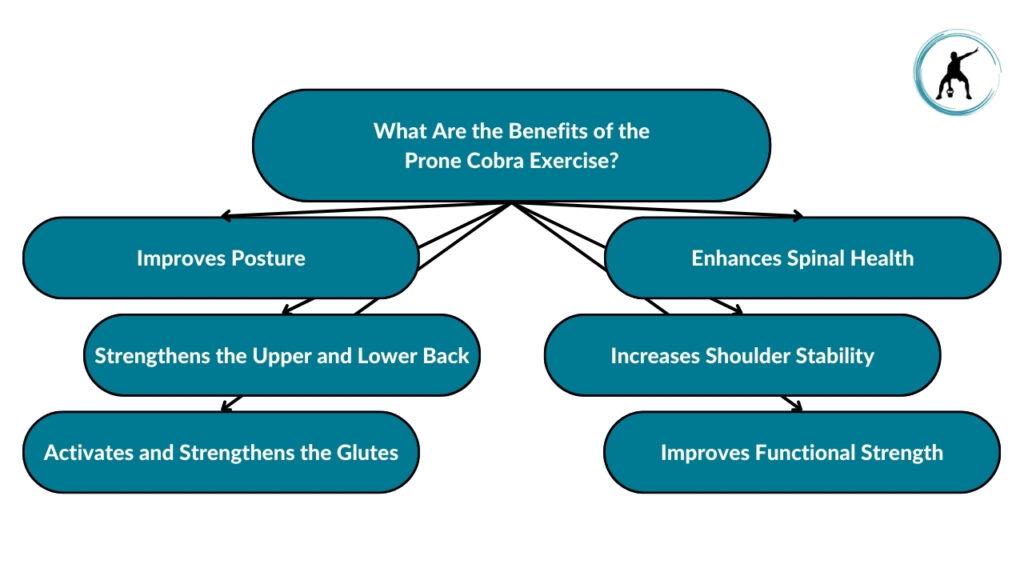
Let’s cover each of these below.
Improves Posture
By strengthening the erector spinae and upper back muscles, the prone cobra exercise helps counteract the common issue of rounded shoulders and forward head posture, encouraging a more upright and aligned posture. I regularly implement this exercise with my clients who have functional thoracic kyphosis to fix their posture muscle imbalances.
A study from PubMed Central titled “The effect of a course of selected corrective exercises on posture, scapula-humeral rhythm and performance of adolescent volleyball players with upper cross syndrome” demonstrated that a course of selected corrective exercises, including the cobra pose on the ground, significantly improved posture, scapula-humeral rhythm, and performance in adolescent volleyball players with upper cross syndrome [1].
Strengthens the Upper and Lower Back
Targeting both the upper and lower back, this exercise ensures comprehensive back strength, which is essential for daily activities and preventing back pain. It isn’t the best muscle-building exercise out there by all means, but it is perfect for strengthening specific back muscles responsible for healthy posture and day-to-day functioning.
A study from PubMed Central titled “Efficacy of core stability training on upper extremity performance in collegiate athletes” concluded that a five-week core stability training program, including exercises like the ball cobra, significantly improved upper limb athletic performance parameters such as the Upper Quarter Y Balance Test (UQ-YBT) and Functional Throwing Performance Index (FTPI) among collegiate athletes [2].
Activates and Strengthens the Glutes
Engaging the glutes provides stability and support for the lower back, highlighting the interconnectedness of muscle groups in maintaining spinal health. Many individuals neglect glute strength, and that’s why they experience lower back pain later in life.
Enhances Spinal Health
The motion of extending the spine against resistance promotes flexibility and mobility in the spinal joints, contributing to overall spinal health and function.
Increases Shoulder Stability
By activating the shoulder stabilizers, the prone cobra exercise contributes to shoulder joint health, which is crucial for a wide range of movements and activities.
Improves Functional Strength
This exercise enhances functional strength, which translates into easier execution of everyday tasks and movements, showcasing the practical benefits of a strong back and core.
What Are the Best Tips for Performing a Prone Cobra Exercise?
The best tips for performing a prone cobra exercise include ensuring torso and leg floor contact, lightly touching or hovering hands, bending and pulling back your elbows, breathing correctly throughout the movement, and controlling your pace.
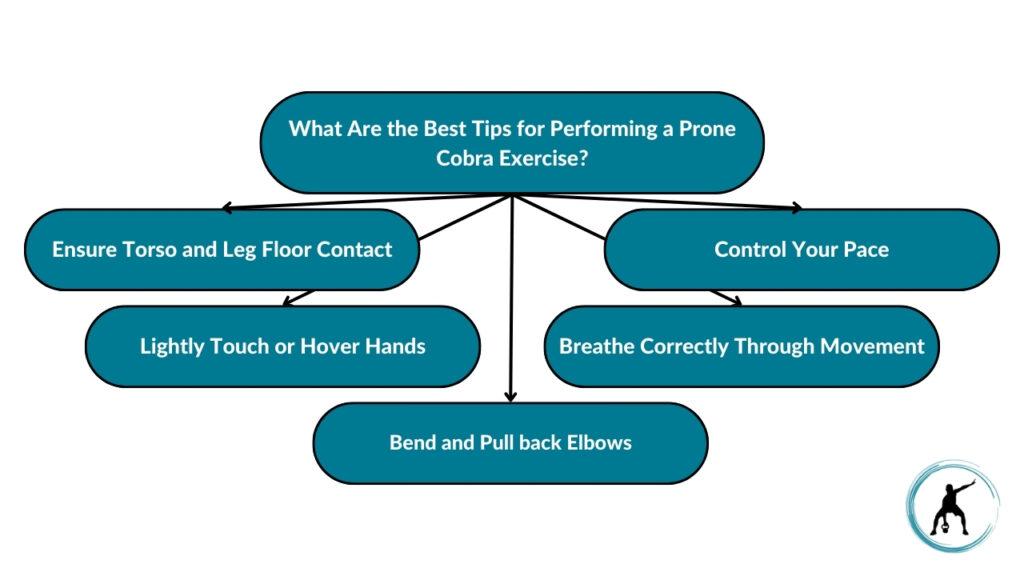
Let’s tackle each of these separately.
Ensure Torso and Leg Floor Contact
Start with your torso firmly on the stability ball and your legs extended, toes touching the floor. This stable base is crucial for proper alignment and muscle engagement.
Lightly Touch or Hover Hands
Initially, lightly touch the ground with your hands or hover them slightly to engage the upper back muscles without relying too much on arm strength.
Bend and Pull back Elbows
As you lift into the cobra position, bend your elbows slightly and pull them back. This action helps target the back muscles more effectively.
Breathe Correctly Through Movement
Inhale as you prepare to lift and exhale as you rise into the cobra position. Proper breathing not only aids in muscle relaxation and contraction but also enhances focus and performance.
Control Your Pace
Move into and out of the cobra position with controlled, deliberate motions. A slower pace increases muscle time under tension, boosting strength gains and reducing injury risk.
Prone Ball Cobra Exercise Variations
Here are some prone ball cobra exercise variations you should consider adding to your back or corrective workouts.
Prone Ball Cobra Hold
This variation focuses on isometric strength by maintaining the peak cobra position.
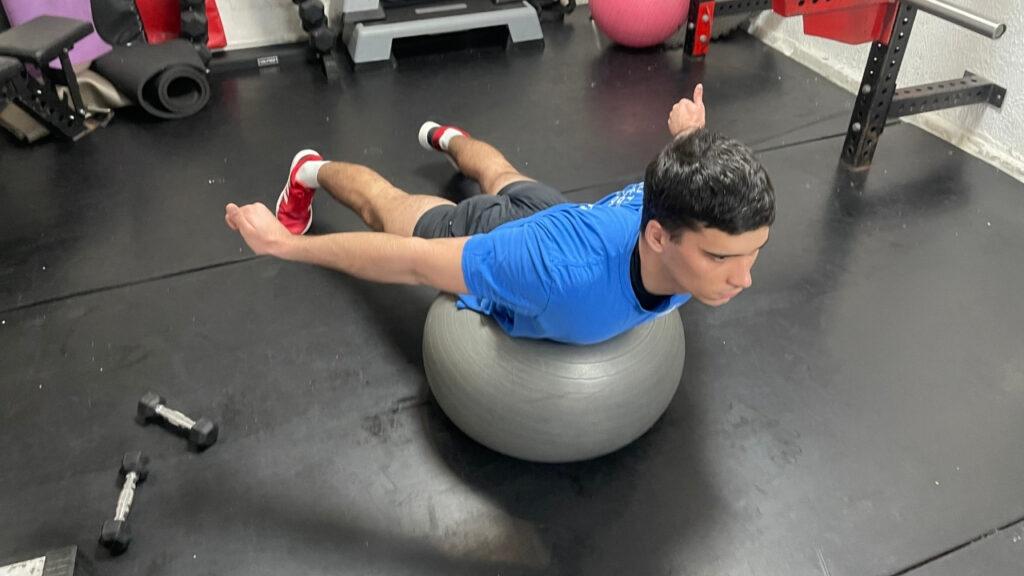
Instructions:
- Begin by lying face down on the stability ball, positioning it under your abdomen.
- Plant your toes firmly on the floor for balance, legs straight and hip-width apart.
- Extend your arms forward, palms facing each other.
- Engage your core and lift your chest off the ball by squeezing your shoulder blades together.
- Rotate your arms so your thumbs point upwards as you enter the cobra position.
- Hold this position, ensuring your arms are extended and elbows slightly bent, for 20-30 seconds.
- Keep your head in a neutral position, aligning it with your spine.
- Breathe deeply and evenly throughout the hold.
- Slowly lower back to the starting position after the hold.
- Repeat for the desired number of repetitions, resting between each.
Pro Tip: Engage your glutes during the hold to support your lower back, enhancing stability and maximizing the exercise’s benefits.
Weighted Prone Ball Cobra
Adding weights increases resistance, offering a greater challenge.
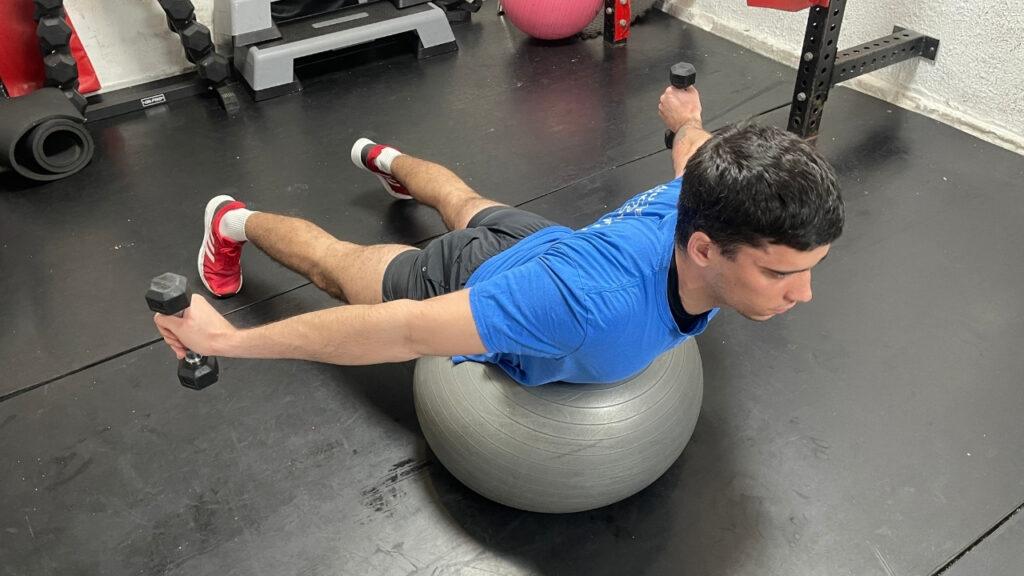
Instructions:
- Position yourself face down on the stability ball, with the ball under your abdomen.
- Hold a light dumbbell in each hand, arms extended in front of you.
- Secure your feet on the floor, legs extended and apart for stability.
- Tighten your core and lift your chest by squeezing the shoulder blades, moving into the cobra position.
- As you lift, rotate your arms to have the thumbs pointing upwards, keeping the weights aligned with your shoulders.
- Ensure a controlled lift, focusing on the muscle contraction and not the weight.
- Hold the peak position briefly, then slowly lower to the starting position while maintaining a grip on the dumbbells.
- Perform 8-10 repetitions, focusing on form and muscle engagement.
- Rest between sets, adjusting weight as necessary for a challenge without compromising form.
Pro Tip: Ensure a warm-up without weights to prepare your muscles and joints, reducing the risk of injury when adding resistance.
Alternating Prone Ball Cobra
Alternates arm movements for dynamic muscle engagement.
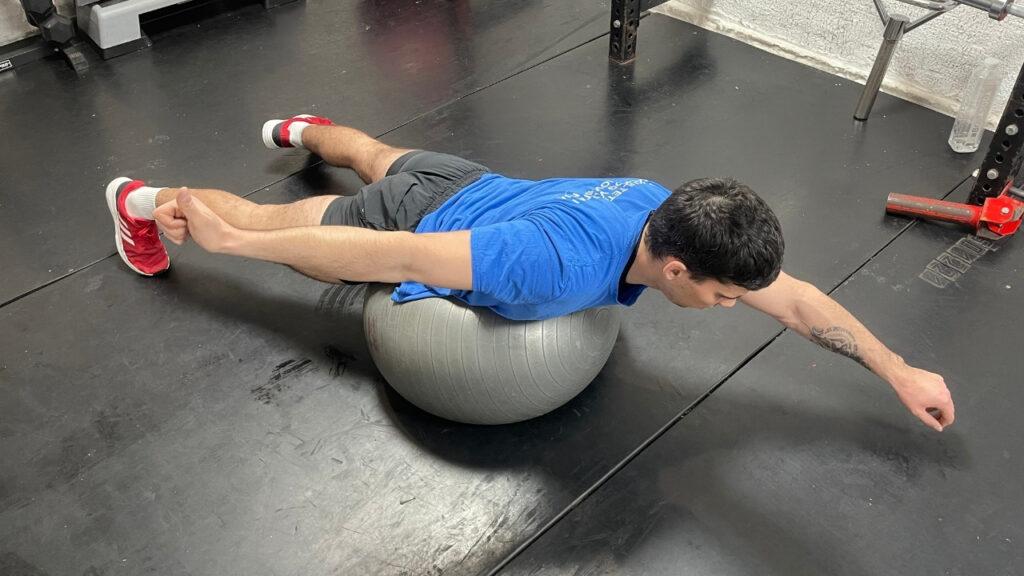
Instructions:
- Lie face down on the stability ball, centering it under your abdomen.
- Extend your arms forward, with palms facing down.
- Plant your toes on the ground, keeping your legs straight and stable.
- Engage your core and lift into the cobra position, raising your chest and shoulders.
- Lift one arm towards the ceiling while the other remains extended forward, then switch arms.
- Ensure each arm alternates with a controlled, smooth motion.
- Keep your gaze downwards to maintain neck alignment with your spine.
- Perform this alternating action for 10-15 repetitions per arm.
- Focus on maintaining balance and stability on the ball throughout the movement.
- Rest between sets, adjusting the number of repetitions based on your fitness level.
Pro Tip: Concentrate on engaging the back muscles of the moving arm for full activation, while the stationary arm focuses on stability.
Prone Ball Cobra Exercise Alternatives
Also, here are some alternative prone ball cobra exercises you should consider.
Superman Exercise
The superman exercise strengthens the back, glutes, and hamstrings through a simultaneous lifting action.
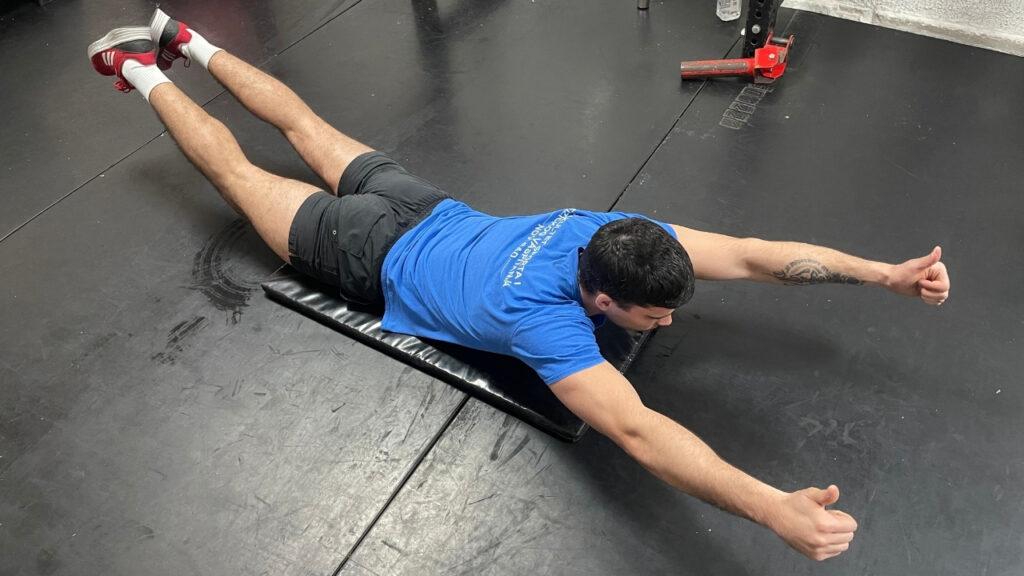
Instructions:
- Lie face down on a mat, arms extended in front of you, legs straight.
- Engage your core and simultaneously lift your arms, chest, and legs off the ground.
- Reach forward with your hands and back with your feet, maintaining a straight line.
- Hold the elevated position for 2-3 seconds, focusing on the contraction in your lower back and glutes.
- Slowly lower back to the starting position without fully relaxing your muscles.
- Perform 10-12 repetitions, ensuring smooth and controlled movements.
- Keep your head neutral, aligning it with your spine throughout the exercise.
- Inhale as you lower, exhale as you lift to maintain proper breathing.
- Rest briefly between sets, aiming for 2-3 sets in total.
Pro Tip: To avoid neck strain, keep your gaze downward towards the mat, not forward, as you lift.
Bird Dog
The bird dog exercise enhances core stability, balance, and back strength, focusing on controlled movements.
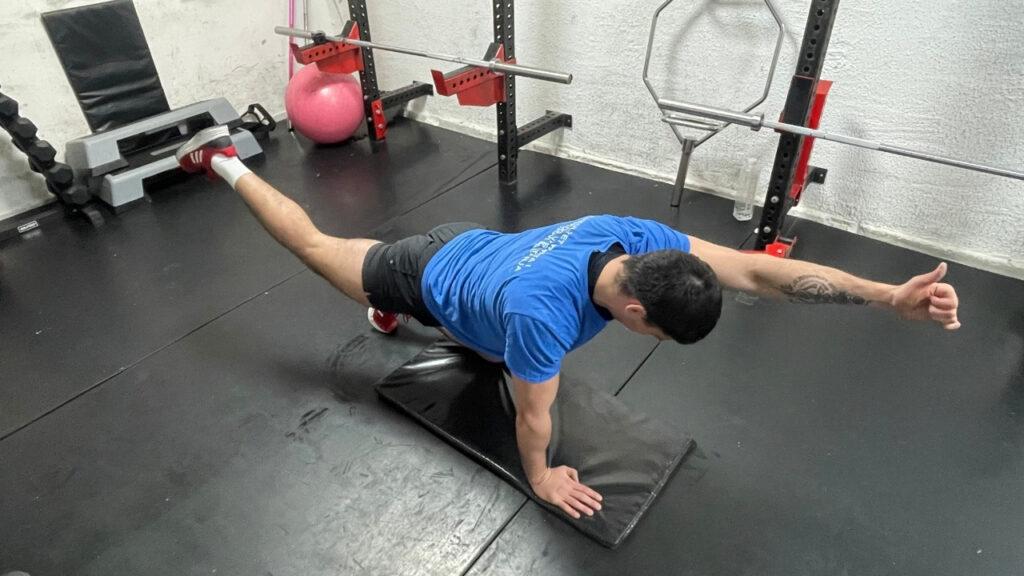
Instructions:
- Start on all fours, hands under shoulders and knees under hips.
- Tighten your core, ensuring your back is flat and stable.
- Extend one arm forward while simultaneously extending the opposite leg back, keeping both straight.
- Hold the extended position for a moment, focusing on balance and core engagement.
- Return to the starting position with controlled movement, then switch sides.
- Perform 10-12 repetitions per side, maintaining form and balance.
- Ensure your movements are slow and deliberate to maximize muscle engagement.
- Keep your gaze down to align your neck with your spine.
- Focus on the quality of movement rather than speed, aiming for 2-3 sets.
Pro Tip: Imagine balancing a glass of water on your back to keep it from tilting or rotating, enhancing core engagement and stability.
Face Pulls
Face pulls target the upper back, shoulders, and rotator cuff muscles, improving posture and shoulder health.
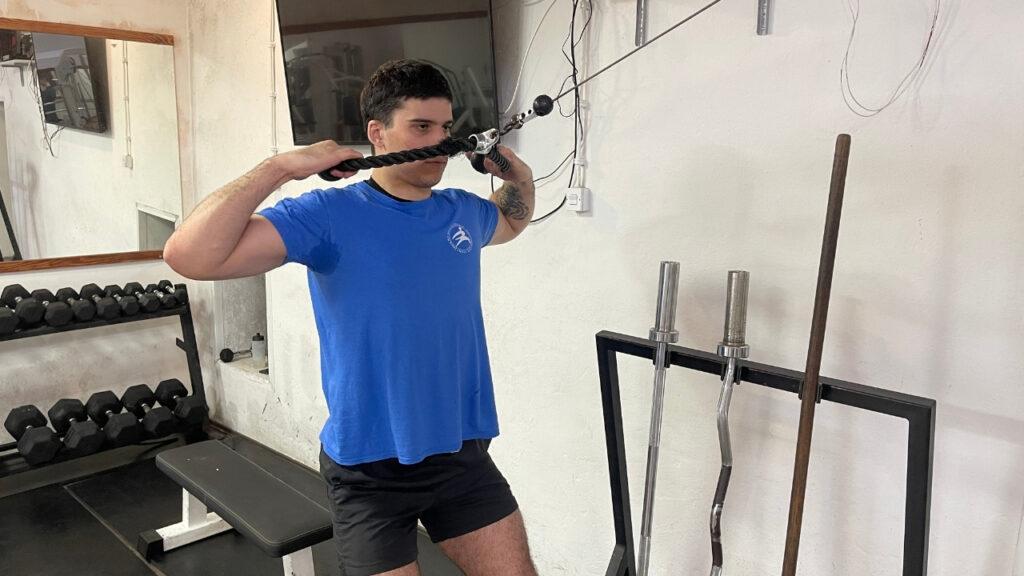
Instructions:
- Attach a rope to a cable machine at about chest height.
- Grasp the rope with both hands, palms facing each other, and step back to create tension.
- Pull the rope towards your face, separating your hands as you do so and keeping elbows high.
- Squeeze your shoulder blades together at the end of the movement.
- Return to the starting position with control, maintaining tension on the cable.
- Perform 10-12 repetitions, focusing on the contraction in the upper back and shoulders.
- Keep your core engaged and stance stable throughout the exercise.
- Adjust the weight to maintain form without compromising the pull quality.
- Aim for 2-3 sets, resting between each for optimal recovery.
Pro Tip: To emphasize the engagement of the rear deltoids and upper back, visualize pulling apart the rope at the end of the movement.
FAQs
What Are the Common Mistakes to Avoid While Performing the Prone Ball Cobra Exercise?
Common mistakes during the prone ball cobra exercise include improper hand placement, inadequate engagement of the abdominal muscles, and incorrect neck alignment. To perform this exercise correctly, individuals should ensure their hands are positioned directly under their shoulders, actively engage their core to support the lower back and maintain a neutral neck position to avoid strain.
How Can Beginners Modify the Prone Ball Cobra Exercise to Make It More Accessible?
Beginners can modify the prone ball cobra exercise by reducing the range of motion and using a smaller stability ball. These modifications help in gradually building the strength required for the full version of the exercise, making it more accessible to individuals who are new to this workout.
Are There Any Specific Breathing Techniques That Should Be Used During the Prone Ball Cobra Exercise?
Specific breathing techniques for the prone ball cobra exercise involve exhaling sharply from your abdomen during the upward phase and inhaling as you lower your body back to the starting position. This breathing pattern helps to oxygenate the muscles effectively and supports the natural movement rhythm of the exercise.
Wrapping Up
The prone ball cobra exercise, performed on a stability ball, is a comprehensive movement that strengthens the back, enhances posture, and improves functional strength. By following the detailed steps provided, including starting position, cobra position entry, and correct hand finishing position, individuals can maximize the benefits of this exercise.
Incorporating variations and understanding the muscles worked, this exercise offers a versatile approach to improving back health and overall fitness.
Whether you’re a beginner looking for modifications or seeking to refine your technique, the prone ball cobra exercise is a valuable addition to any fitness or rehabilitation routine, promoting spinal health, muscle strength, and stability.
Start Building Your Dream Body Today
Ready to elevate your fitness game without falling into the trap of dull, repetitive routines that just don’t deliver? Imagine sculpting your ideal physique and boosting your health, all while still enjoying life’s pleasures, like those irresistible weekend getaways and your aunt’s legendary cheesecake. With our online fitness and nutrition coaching service, you don’t have to compromise. Dive into a personalized fitness journey that blends perfectly with your lifestyle, not against it. Book your completely free discovery consultation today, and take the first step towards a transformation that doesn’t require giving up the joys of life.

“I was skeptical about online fitness coaching, but Functional Body Savage completely changed my perspective. Vanja and Radomir’s personalized approach and attention to detail have helped me achieve goals I never thought possible. I’m stronger, more confident, and grateful for their guidance.”
Emily Thompson, San Francisco, CA
Learn More About Our Online Coaching ServiceReferences:
- Firouzjah MH, Firouzjah EMAN, Ebrahimi Z. The effect of a course of selected corrective exercises on posture, scapula-humeral rhythm and performance of adolescent volleyball players with upper cross syndrome. BMC Musculoskelet Disord. 2023;24(1):489. Published 2023 Jun 14. doi:10.1186/s12891-023-06592-7
- Jha P, Nuhmani S, Kapoor G, et al. Efficacy of core stability training on upper extremity performance in collegiate athletes. J Musculoskelet Neuronal Interact. 2022;22(4):498-503.

